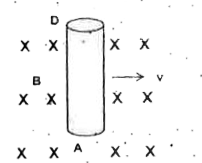The counductor AD moves to the right in a uniform magnetic field directed into the plane of the paper.

(a) The free electron in AD will move toward A
(b) D will acquire a positive potential with respect to A
(c ) A current will flow from A→D in AD in closed loop
(d) The current in AD flows from lower to higher potential
The correct Answer is:A, B, C, D
(a,b,c,d): Use concept of motional emf
Topper's Solved these Questions
- ELECTROMAGNETIC INDUCTIONBOOK - CENGAGE PHYSICSCHAPTER - ELECTROMAGNETIC INDUCTIONEXERCISE - Exercises Asserton - Reasoning
8 Videos
- ELECTROMAGNETIC INDUCTIONBOOK - CENGAGE PHYSICSCHAPTER - ELECTROMAGNETIC INDUCTIONEXERCISE - Exercises Linked Comprehension
36 Videos
- ELECTROMAGNETIC INDUCTIONBOOK - CENGAGE PHYSICSCHAPTER - ELECTROMAGNETIC INDUCTIONEXERCISE - Exercises Single Correct
79 Videos
- ELECTROMAGENTIC INDUCTIONBOOK - CENGAGE PHYSICSCHAPTER - ELECTROMAGENTIC INDUCTIONEXERCISE - QUESTION BANK
40 Videos
- ELECTRON,PHONTS,PHOTOELECTRIC EFFECT & X-RAYSBOOK - CENGAGE PHYSICSCHAPTER - ELECTRON,PHONTS,PHOTOELECTRIC EFFECT & X-RAYSEXERCISE - dpp 3.3
15 Videos
Similar Questions
A conducting rod AC of length 4l is rotated about point O in a uniform magnetic field →B directed into the plane of the paper. AO=landOC=3l. Find VA−VC.

View SolutionAn α-particle and a proton are moving in the plane of the paper in a region where there is a uniform magnetic field →B directed normal to the plane of the paper. If the two particles have equal linear momenta, what will be the ratio of their trajectories in the field?
View Solution
Knowledge Check
The conductor AD moves to the right in a magnetic field directed into the paper. Then
 Athe free electrons in Ad will move towards ABD will acquire a positive potential with resptect to ACIf D and A are joined by a conductor externally. A current will flow from A to D in ADDthe current in AD flows from lower to higher potential
Athe free electrons in Ad will move towards ABD will acquire a positive potential with resptect to ACIf D and A are joined by a conductor externally. A current will flow from A to D in ADDthe current in AD flows from lower to higher potentialA long conducting wire AH is moved over a conducting triangular wire CDE with a constant velocity v in a uniform magnetic field →B directed into the plane of the paper. Resistance per unit length of each wire is ρ. Then
 A(a) a constant clockwise induced will flow in the closed loopB(b) an increasing anticlockwise induced current will flow in the closed loopC(c ) a decreasing anticlockwise induced current will flow in the closed loopD(d) an constant anticlockwise induced current will flow in the closed loop
A(a) a constant clockwise induced will flow in the closed loopB(b) an increasing anticlockwise induced current will flow in the closed loopC(c ) a decreasing anticlockwise induced current will flow in the closed loopD(d) an constant anticlockwise induced current will flow in the closed loopA conducting rod PQ of length L=1.0m is moving with a uniform speed v=2.0ms−1 in a uniform magnetic field B=4.0T directed into the plane of the paper.
A capacitor of capacity C=10μF is connected as shown in , then
 A(a) qA=+80μCandqB−80μCB(b) qA=−80μCandqB+80μCC( c) qA=0=qBD(d) charge stored in the capacitor increases exponentially with time
A(a) qA=+80μCandqB−80μCB(b) qA=−80μCandqB+80μCC( c) qA=0=qBD(d) charge stored in the capacitor increases exponentially with time
A bar of mass m and length l moves on two frictionless parallel rails in the presence of a uniform magnetic field directed into the plane of the paper. The bar is given and initial velocity vi to the right and released. Find the velocity of bar, induced emf across the bar and the current in the circuit as a function of time

View SolutionPredict the direction of the induced current in the rectangular loop abcd as it is moved into the region of a uniform magnetic filed →B directed normal to the plane of the loop.

View SolutionA closed loop with the geometry shown in Fig. 3.9 is placed in a uniform magnetic field direction into the plane of the paper. If the magnetic field decreases with time, determine the direction of the induced emf in this loop.

View SolutionA conducting rod PQ of length 1m is moving with uniform velocity of 2m/s in a uniform magnetic field of 2T directed inot the plane of paper. A capacitor of capacity c=10μF is connected as shown. Then :

View SolutionA wire is bent to form the double loop shown in figure. There is a uniform magnetic field directed into the plane of the loop. If the magnitude of this field is decreasing, current will flow from:

View Solution